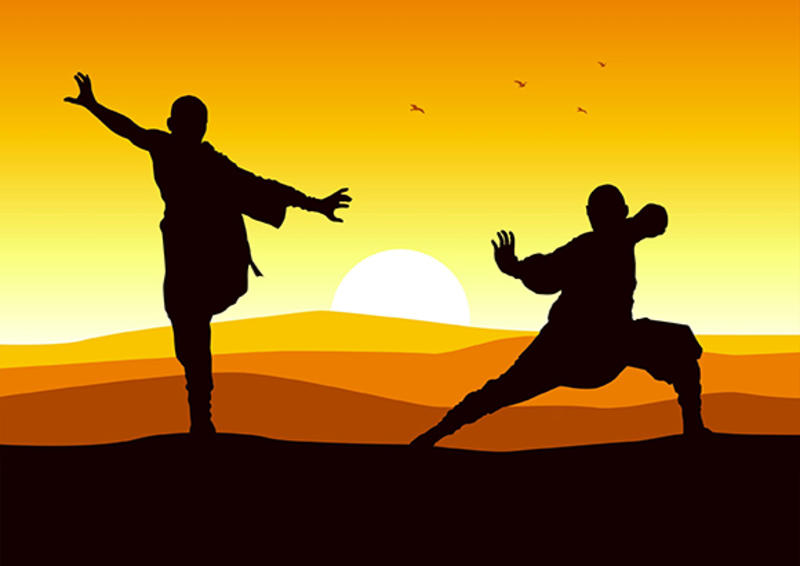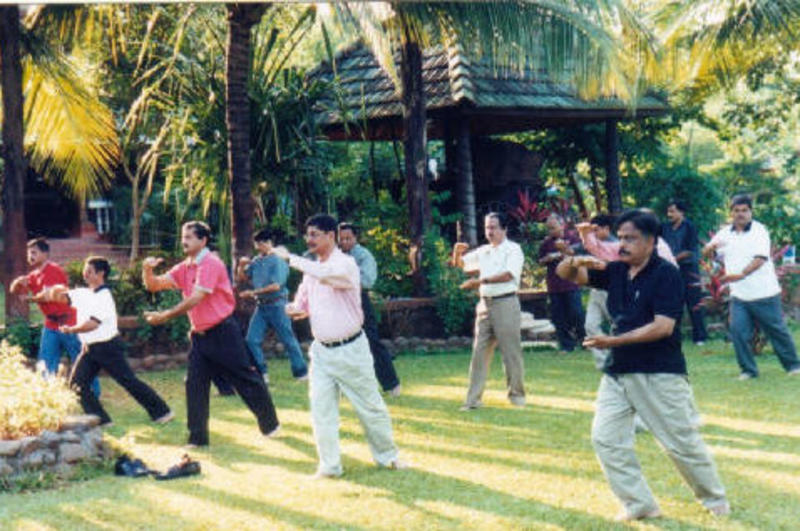Learn Taichi / Tai chi Qi gong corporate workshop best course of top ten martial arts class in Mumbai


Taichi is a Chinese martial art practiced slowly with soft, flowing movements like a form of meditation in motion, comparable to Indian Yoga to deal with stress and obtain health benefits.
Qi Gong is a traditional Chinese Medicine technique that is believed to be at least 4,000 years old. As we practice the Qi Gong over a period of time we can begin to feel this field energy emanating from us. This feeling of qi is first between our hands, as we begin to do Qi Gong our awareness of the energy & our vitality increases.
Tai Chi & Qi Gong are beneficial for chronic conditions such as cancer, chronic fatigue syndrome, osteoporosis, high blood pressure, cardiovascular disease, diabetes, stomach ulcers, asthma etc. At CATS Mumbai we teach in a systematic & scientific manner
GENERAL KNOWLEDGE
Qigong (/ˈtʃiːˈɡɒŋ/), qi gong, chi kung, or chi gung (simplified Chinese: 气功; traditional Chinese: 氣功; pinyin: qìgōng; Wade–Giles: ch‘i kung; literally: “Life Energy Cultivation”) is a holistic system of coordinated body posture and movement, breathing, and meditation used for the purposes of health, spirituality, and martial arts training. With roots in Chinese medicine, philosophy, and martial arts, qigong is traditionally viewed as a practice to cultivate and balance qi (chi), translated as “life energy”. We teach this in our Mumbai center
Qigong practice typically involves moving meditation, coordinating slow flowing movement, deep rhythmic breathing, and calm meditative state of mind. Qigong is now practiced throughout China and worldwide for recreation, exercise and relaxation, preventive medicine and self-healing, alternative medicine, meditation and self-cultivation, and training for martial arts.
Qi (or chi) is often translated as life energy, referring to energy circulating through the body; though a more general definition is universal energy, including heat, light, and electromagnetic energy; and definitions often involve breath, air, gas, or the relationship between matter, energy, and spirit. Qi is the central underlying principle in traditional Chinese medicine and martial arts. Gong (or kung) is often translated as cultivation or work, and definitions include practice, skill, mastery, merit, achievement, service, result, or accomplishment, and is often used to mean gongfu (kung fu) in the traditional sense of achievement through great effort. The two words are combined to describe systems to cultivate and balance life energy, especially for health. To learn Tai Chi Qi Gong contact our Mumbai center.
Practices
Qigong comprises a diverse set of practices that coordinate body (調身), breath (調息), and mind (調心) based on Chinese philosophy. Practices include moving and still meditation, massage, chanting, sound meditation, and non-contact treatments, performed in a broad array of body postures. Qigong is commonly classified into two foundational categories: 1) dynamic or active qigong (dong gong), with slow flowing movement; and 2) meditative or passive qigong (jing gong), with still positions and inner movement of the breath. From a therapeutic perspective, qigong can be classified into two systems: 1) internal qigong, which focuses on self-care and self-cultivation, and; 2) external qigong, which involves treatment by a therapist who directs or transmits qi.
As moving meditation, qigong practice typically coordinates slow stylized movement, deep diaphragmatic breathing, and calm mental focus, with visualization of guiding qi through the body. While implementation details vary, generally qigong forms can be characterized as a mix of four types of practice: dynamic, static, meditative, and activities requiring external aids.
- Dynamic practice
involves fluid movement, usually carefully choreographed, coordinated with breath and awareness. Examples include the slow stylized movements of T’ai chi ch’uan, Baguazhang, and Xing Yi Quan. Other examples include graceful movement that mimics the motion of animals in Five Animals (Wu Qin Xi qigong), White Crane, and Wild Goose (Dayan) Qigong. As a form of gentle exercise, qigong is composed of movements that are typically repeated, strengthening and stretching the body, increasing fluid movement (blood, synovial, and lymph), enhancing balance and proprioception, and improving the awareness of how the body moves through space.
- Static practice
involves holding postures for sustained periods of time. In some cases this bears resemblance to the practice of Yoga and its continuation in the Buddhist tradition. For example Yiquan, a Chinese martial art derived from xingyiquan, emphasizes static stance training. In another example, the healing form Eight Pieces of Brocade (Baduanjin qigong) is based on a series of static postures.
- Meditative practice
utilizes breath awareness, visualization, mantra, chanting, sound, and focus on philosophical concepts such as qi circulation, aesthetics, or moral values. In traditional Chinese medicine and Daoist practice, the meditative focus is commonly on cultivating qi in dantian energy centers and balancing qi flow in meridian and other pathways. In various Buddhist traditions, the aim is to still the mind, either through outward focus, for example on a place, or through inward focus on the breath, a mantra, a koan, emptiness, or the idea of the eternal. In the Confucius scholar tradition, meditation is focused on humanity and virtue, with the aim of self-enlightenment.
- Use of external agents
Many systems of qigong practice include the use of external agents such as ingestion of herbs, massage, physical manipulation, or interaction with other living organisms. For example, specialized food and drinks are used in some medical and Daoist forms, whereas massage and body manipulation are sometimes used in martial arts forms. In some medical systems a qigong master uses non-contact treatment, purportedly guiding qi through his or her own body into the body of another person.
Techniques
Whether viewed from the perspective of exercise, health, philosophy, or martial arts training, several main principles emerge concerning the practice of qigong:
- Intentional movement: careful, flowing balanced style
- Rhythmic breathing: slow, deep, coordinated with fluid movement
- Awareness: calm, focused meditative state
- Visualization: of qi flow, philosophical tenets, aesthetics
- Chanting/Sound: use of sound as a focal point
Additional principles:
- Softness: soft gaze, expressionless face
- Solid Stance: firm footing, erect spine
- Relaxation: relaxed muscles, slightly bent joints
- Balance and Counterbalance: motion over the center of gravity
Advanced goals:
- Equanimity: more fluid, more relaxed
- Tranquility: empty mind, high awareness
- Stillness: smaller and smaller movements, eventually to complete stillness
Martial arts applications
The practice of Tai Chi Qi Gong is an important component in both internal and external style Chinese martial arts. Focus on qi is considered to be a source of power as well as the foundation of the internal style of martial arts (Neijia). T’ai Chi Ch’uan, Xing Yi Quan, and Baguazhang are representative of the types of Chinese martial arts that rely on the concept of qi as the foundation. Extraordinary feats of martial arts prowess, such as the ability to withstand heavy strikes (Iron Shirt, 鐵衫) and the ability to break hard objects (Iron Palm, 鐵掌) are abilities attributed to qigong training. At CATS Mumbai we follow the scientific methodology of teaching
